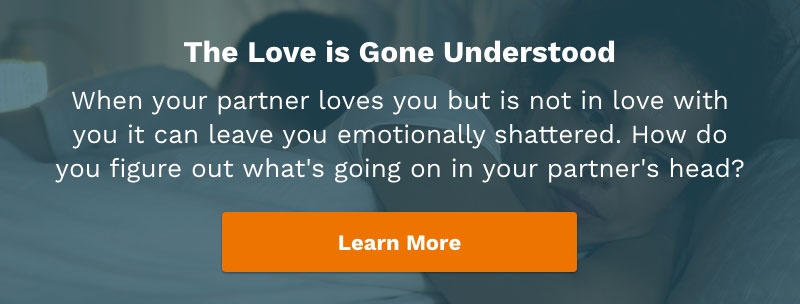
6 Min Read
Contents
- Defining Trauma Bonding – It May Not Mean What You Think It Means
- How Did I Get Here? Understanding How Trauma Bonding Begins
- What Trauma Bonding In Relationships Looks Like
- Breaking Free – What To Do If You’re Dealing With Trauma Bonding In A Relationship
- What To Take Away
How’s your relationship? Do you walk on eggshells around your partner? Are you on a pendulum of emotional distance and problems today and love and affection tomorrow?
If so, you may be experiencing trauma bonding.
No? You’re genuinely in love, and things will be fine – soon. Right?
But “soon” comes and then it goes, and you find yourself waiting for things to change all over again.
This is a common dynamic in relationships based on trauma bonding.
Defining Trauma Bonding – It May Not Mean What You Think It Means
Before we go on, let’s correct a common misconception.
Trauma bonding in a relationship IS NOT the same as being bonded over a shared trauma.
To be exceptionally clear – two people who become close because they’ve each experienced a traumatic event (car accident, abusive parents or exes, dire health scare, death of a loved one, etc.), ARE NOT trauma bonded.
In other words, bonding over trauma is not the same as trauma bonding.
Trauma bonding in a relationship is attachment to someone created through a regular cycle of abuse and amends.
It’s like being in love with a Jekyll and Hyde partner.
One minute, you’re experiencing emotional, verbal, physical, or even sexual abuse. The next, you’re being love-bombed with “I love you's,” gifts, romantic gestures, and other forms of affection.
These swings create emotional whiplash that causes confusion and psychological exhaustion, wearing down a person’s ability to maintain boundaries.
It also destroys self-esteem and confidence, making the love-bombing phase feel like a relief and drawing a partner in with the promise of change, love, and happiness.
Once the cycle starts, it can go on for years, making the bond harder and harder to break.
The clearest characteristics of a trauma bond relationship include:
Intermittent reinforcement. A trauma bond is reinforced by intermittent positive behaviors interspersed with hostile or abusive actions. This inconsistency causes victims to cling to the positive moments in the hope that things will improve.
- Dependency. Emotional dependence is rooted in the belief that the other person is their only possible source of comfort, understanding, acceptance, and love.
- Cognitive Dissonance. Cognitive dissonance is the struggle with conflicting beliefs about the other person or the relationship, characterized by a strong desire to only recognize or admit the positives about the person or relationship.
- Isolation. Individuals involved in trauma-bonded relationships may become isolated from others. This allows the sense of exclusivity to grow and fosters the belief that others won’t understand their unique connection.
- Fear of abandonment. As self-doubt takes root, the fear of abandonment and being alone becomes stronger and stronger. These fears contribute to deepening the bond and dependence, prolonging the tolerance of abusive behavior.
How Did I Get Here? Understanding How Trauma Bonding Begins
A relationship being kept together through a trauma bond begins as most others do – positive and fulfilling.
In fact, the early stages of the relationship create a strong emotional bond which becomes the foundation for the trauma bond that develops later as behaviors change.
Over time, as the relationship faces challenges and stressors (think job loss, health issues, even children), the strain initiates negative changes and behaviors (i.e., abuse) in one partner.
This is where the intermittent positive reinforcement becomes a factor.
The person causing harm cycles through abusive behavior and moments of kindness, apologies, and promises to change. These fluctuations create confusion and heighten the emotional impact of both the positive and negative interactions, thus creating a traumatic bond.
Most individuals who experience trauma bonding don’t recognize what’s happening.
It’s not difficult to understand. When you love someone and have invested a lot of time in them, the idea that there could be a detrimental shift that becomes a permanent cycle within the relationship is hard to grasp.
So bad behavior happens, and the thought is,
OMG – this is out of character and wrong. Is it my fault? What can I do?”
Then good behavior follows, and the thought is,
Okay, things are fine now. He/she loves me and apologized. Everything will be okay.”
And then the cycle repeats – compounded by the memories of past lows and highs.
Trauma bonding is something Dr. Kurt has seen a great deal of in his practice. When asked about it he had this to say,
Justifying ('It's my fault...') and rationalizing ('Things are fine now.') are common psychological responses to abuse and the trauma bonding that can result from it. If you find yourself doing either of these that's a warning sign. Another sign is over focusing on the highs and minimizing the lows. So, if you're twisting things around in your head to make your relationship make sense, be acceptable or tolerable, you're very likely enabling behavior you should be rejecting."
What Trauma Bonding In A Relationship Looks Like
It’s important to understand that trauma bonding is not restricted to romantic relationships - it can form in ANY relationship.
Consider the following scenarios:
Abusive Romance
Scenario: Sarah and Mark have been together for 4 years. Mark lost his job a year ago and has been under a lot of stress as he’s struggled to find another. As the stress has intensified he’s become emotionally and verbally abusive toward Sarah.
They go through cycles of intense arguments, during which Mark belittles and demeans Sarah. However, after each argument, Mark apologizes, showers her with affection, and promises not to do it again.
Sarah, desperately seeking the positive connection she once had with Mark, becomes emotionally dependent on these intermittent moments of kindness. This cycle repeats, creating a solid trauma bond.
Toxic Friendship
Scenario: Amy and Jessica have been best friends since 3rd grade. But over the years, Jessica has become increasingly manipulative and controlling, expecting Amy to be at her beck and call.
Amy’s now caught in a pattern where Jessica alternates between being supportive and emotionally draining.
Despite the toxicity, Amy clings to the positive memories and shared experiences from their long friendship and feels loyalty and responsibility toward Jessica, making it difficult for her to distance herself.
Parental Emotional Neglect
Scenario: Alex grew up in a household where emotional neglect was the norm.
His parents were occasionally affectionate and provided emotional support, but most of the time were emotionally distant. As a child, he found himself consumed with trying to find ways to elicit positive emotions from his parents.
As an adult, Alex now struggles to form healthy relationships, finding himself with partners who replicate the pattern of emotional inconsistency he experienced in childhood.
Workplace Bullying
Scenario: Chris’s boss, Lisa, is a bully. She oscillates between being highly critical and offering praise, keeping her employees on edge.
Despite this dynamic, Chris has become emotionally attached to the job, colleagues, and even Lisa as he craves her praise and approval. This emotional attachment, combined with the intermittent positive reinforcement, creates a trauma bond that makes it challenging for Chris to leave the job even though he feels constantly stressed.
Breaking Free – What To Do If You’re Dealing With Trauma Bonding In A Relationship
There’s nothing healthy about being in a trauma-bonded relationship. Even if it began as a loving, positive connection, staying in a situation that’s become abusive and toxic that keeps you in a perpetual state of hoping for change will take a significant psychological toll.
Allowed to continue, trauma bonding can contribute to mental health issues such as,
- Anxiety
- Depression
- Loss of identity
- PTSD (Post-traumatic stress disorder)
So, how do you break free?
The biggest and most crucial step is to,
- Acknowledge the problem. Recognizing and accepting that you’re in a trauma-bonded relationship isn’t easy, but you can’t make changes to something you don’t know needs changing. So, understanding and admitting that the pattern is a cycle of abuse and not normal or acceptable is crucial.
From there, consider the following steps to help initiate change:
- Educate yourself. Understanding the psychological aspects of the bond can empower you to break free.
- Build a support system. Connecting with friends, family, or a support group who can offer understanding and assistance can give you the strength you need to make changes.
- Create distance. Start slowly to physically and emotionally distance yourself from the person causing harm. This may involve setting boundaries, limiting contact, or, in extreme cases, ending the relationship.
- Establish boundaries. Clearly define boundaries with the person causing harm and be firm in holding to them.
- Seek professional help. A trauma bond is hard to break. You’ll likely need the help of a qualified counselor to provide guidance, support, and tools to help change your toxic relationship.
Note: if you’re in an abusive relationship, your safety and the safety of your family need to be your first priority. If this is the case, please reach out to local resources or the National Domestic Violence Hotline at 800-799-7233 for immediate help.
What To Take Away
Not only is a trauma bond difficult to break, it’s also hard to recognize.
If you’re not sure whether your relationship is being held together by a loving bond or a traumatic one, ask yourself the following questions:
- Do you ever make excuses for or justify your partner’s treatment of you?
- Do you feel responsible for the negative treatment you experience?
- Do you need to hide things about your relationship from friends and family?
- Do you ever feel your partner is gaslighting you?
- Have you broken ties with people you cared about because they wouldn’t understand your relationship?
If you answered yes to any of these questions, it’s time to consider the health of your relationship.
Remember:
- Trauma bonding isn’t generally how a relationship starts - it typically develops later.
- Allowing the cycle of intermittent reinforcement to continue will cause you significant mental health problems.
- Once you’re trauma-bonded, it requires intentional effort to change. Things won’t change on their own or with time, and the cycle won’t magically stop.
- You’ll almost certainly need professional help to make permanent changes.
- No amount of abusive behavior is acceptable.
A healthy relationship is held together with bonds rooted in love, trust, and respect. If you’re in a cycle of abuse, hoping for change only to be disappointed when the change doesn’t stick, there’s a larger version of change needed – the breaking of your trauma bond.
Looking for More? Check Out These Articles
- Are The Changes During Middle Life ALWAYS A Midlife Crisis?
- I Feel Like He's Virtually Cheating On Me, But He Says Porn Isn't Cheating
- He Cheated On Me - AGAIN!
- Get More Help with Abusive Relationships
























































Comments
Currently, there are no comments. Be the first to post one!